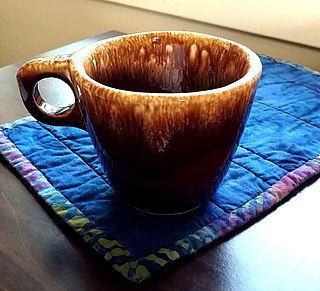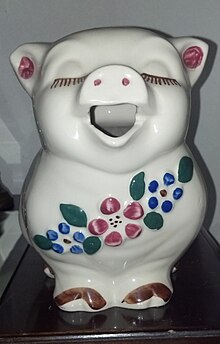
Zanesville is a city in and the county seat of Muskingum County, Ohio, United States. Located at the confluence of the Licking and Muskingum rivers, the city is approximately 52 miles (84 km) east of Columbus and had a population of 24,765 as of the 2020 census, down from 25,487 as of the 2010 census. Historically the state capital of Ohio from 1810 to 1812, Zanesville anchors the Zanesville micropolitan area and is part of the greater Columbus-Marion-Zanesville combined statistical area.

Encaustic or inlaid tiles are ceramic tiles in which the pattern or figure on the surface is not a product of the glaze but of different colors of clay. They are usually of two colours but a tile may be composed of as many as six. The pattern appears inlaid into the body of the tile, so that the design remains as the tile is worn down. Encaustic tiles may be glazed or unglazed and the inlay may be as shallow as 1⁄8 inch (3 mm), as is often the case with "printed" encaustic tile from the later medieval period, or as deep as 1⁄4 in (6.4 mm).

Frederick Hurten Rhead (1880–1942) was a ceramicist and a major figure in the Arts and Crafts movement. A native of England, he worked as a potter in the United States for most of his career. In addition to teaching pottery techniques, Rhead was highly influential in both studio and commercial pottery. He worked for the Roseville Pottery, established his own Rhead Pottery (1913–1917), and in 1935 designed the highly successful Fiesta ware for Homer Laughlin China Company.

Hull pottery began production in 1905 in Crooksville, Ohio, under the leadership of Addis Emmet (A.E.) Hull. The Hull Pottery Company's early lines consisted of common utilitarian stoneware, semi-porcelain dinnerware and decorative tile. The company quickly established a firm market and enjoyed an excellent reputation for producing quality ceramics.
The Fiesta Tableware Company is a ceramics manufacturer located in Newell, West Virginia, United States. Established in 1871, it is widely known for its Art Deco glazed dinnerware line, Fiesta. In 2002, The New York Times called Fiesta "the most collected brand of china in the United States".

The Roseville Pottery Company was an American art pottery manufacturer in the 19th and 20th centuries. Along with Rookwood Pottery and Weller Pottery, it was one of the three major art potteries located in Ohio around the turn of the 20th century. Though the company originally made simple household pieces, the Arts and Crafts–inspired designs proved popular, and Roseville pieces are now sought after by collectors.

In 1872, Samuel A. Weller founded Weller Pottery in Fultonham, Ohio, United States. Originally, his business consisted of a small cabin and one beehive kiln, and Weller produced flower pots, bowls, crocks, and vases. By 1905, Weller Pottery was the largest pottery in the country. It mass-produced art pottery until about 1920, and it produced commercial lines until the pottery closed in 1948.
Red Wing pottery refers to American stoneware, pottery, or dinnerware items made by a company initially set up in Red Wing, Minnesota, in 1861 by German immigrant John Paul, which changed its names several times until finally settling on Red Wing Potteries, Inc. in 1936. The pottery factory that started in 1861 continues to the present day under the names of Red Wing Pottery and Red Wing Stoneware. There was a respite in production when Red Wing Pottery Sales, Inc. had a strike in 1967 causing them to temporarily cease trading. The company still makes both zinc/Bristol glazed products as well as salt-glazed, hand-thrown, kiln fired items.

J.A. Bauer Pottery is an American pottery that was founded in Paducah, Kentucky in 1895 and operated for most of its life in Los Angeles, California. It closed in 1962.

Gladding, McBean is a ceramics company located in Lincoln, California. It is one of the oldest companies in California, a pioneer in ceramics technology, and a company which has "contributed immeasurably" to the state's industrialization. During the heyday of architectural terra cotta, the company "dominated the industry in California and the Far West."

Franciscan Ceramics are ceramic tableware and tile products produced by Gladding, McBean & Co. in Los Angeles, California, US from 1934 to 1962, International Pipe and Ceramics (Interpace) from 1962 to 1979, and Wedgwood from 1979 to 1983. Wedgwood closed the Los Angeles plant, and moved the production of dinnerware to England in 1983. Waterford Glass Group plc purchased Wedgwood in 1986, becoming Waterford Wedgwood. KPS Capital Partners acquired all of the holdings of Waterford Wedgwood in 2009. The Franciscan brand became part of a group of companies known as WWRD, an acronym for "Wedgwood Waterford Royal Doulton." WWRD continues to produce the Franciscan patterns Desert Rose and Apple.

Catalina Pottery is the commonly used name for Catalina Clay Products, a division of the Santa Catalina Island Company, which produced brick, tile, tableware and decorative pottery on Santa Catalina Island, California. Catalina Clay Products was founded in 1927. Gladding, McBean & Co. acquired all of the assets of the company in 1937 and moved all production to its Franciscan dinnerware division in Los Angeles.

Pacific Clay Products, founded 1892, was created by the merger of several Southern California potteries in the US. The company began producing utilitarian pottery in the 1920s, and introduced solid color earthenware dinnerware in 1932. The primary site for the production of ceramic tableware, kitchenware, and art ware was based in the company's Lincoln Heights, Los Angeles plant at 306 West Avenue 26. Pacific Clay ceased production of ceramic dinnerware and art ware in 1942. After 1942, Pacific Clay produced sewer tile and brick. The company ceased production of sewer tile in 1997. The company continues to produce brick products in Lake Elsinore, California. The company has been owned by David H. Murdock since 1973.

Vernon Kilns was an American ceramic company in Vernon, California, US. In July 1931, Faye G. Bennison purchased the former Poxon China pottery renaming the company Vernon Kilns. Poxon China was located at 2300 East 52nd Street. Vernon produced ceramic tableware, art ware, giftware, and figurines. The company closed its doors in 1958.

California pottery includes industrial, commercial, and decorative pottery produced in the Northern California and Southern California regions of the U.S. state of California. Production includes brick, sewer pipe, architectural terra cotta, tile, garden ware, tableware, kitchenware, art ware, figurines, giftware, and ceramics for industrial use. Ceramics include terra cotta, earthenware, porcelain, and stoneware products.
Samuel Augustus Weller, one of the pioneer pottery manufacturers of Ohio in the United States, founded the S.A. Weller Pottery in Fultonham, Ohio, in 1872. In 1882 he moved the business to Zanesville, Ohio, and for more than a half-century Weller Pottery produced both utilitarian pieces and more decorative art pottery lines.

The American Encaustic Tiling Company was founded in New York, New York in 1875, later establishing a factory in Zanesville, Ohio, in 1892. Their tiles were intended to compete with the English tiles that were selling in the United States for use in fireplaces and other architectural locations. The first glazed tiles were made in 1880 and embossed tiles were made in 1881. By 1890, they were the largest tile company in the world, and the small town of Zanesville nearly tripled in size over a thirty-year period as more people found work with the company. The firm closed in 1935 and was then reopened in 1937 as the Shawnee Pottery.

American art pottery refers to aesthetically distinctive hand-made ceramics in earthenware and stoneware from the period 1870-1950s. Ranging from tall vases to tiles, the work features original designs, simplified shapes, and experimental glazes and painting techniques. Stylistically, most of this work is affiliated with the modernizing Arts and Crafts (1880-1910), Art Nouveau (1890–1910), or Art Deco (1920s) movements, and also European art pottery.

The J. B. Owens Pottery Company, informally known as Owens Pottery, was an American art pottery and tile company that flourished for a few years around the turn of the 20th century.

Mary K. Grant, was an American industrial designer. Grant is known for her ceramic designs for Franciscan Ceramics manufactured by Gladding, McBean & Co. Grant designed several fine china and earthenware shapes for Gladding, McBean. Grant designed the American Franciscan dinnerware shapes for Desert Rose, Apple, and Ivy. Grant's Franciscan fine china shape Encanto was chosen by the Metropolitan Museum of Art for good design in 1951.


















